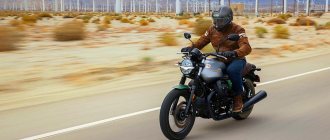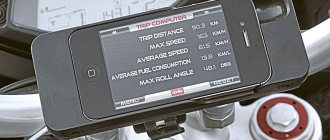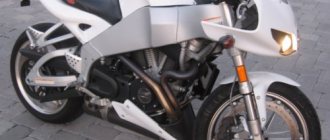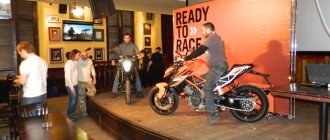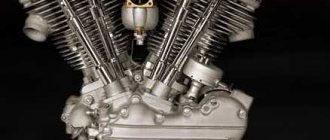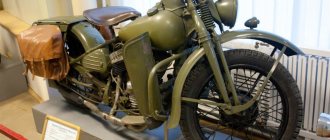Test drive Moto MoriniCorsaro 1200
There are a huge number of motorcycle companies in the world. Large and small, famous and not so famous, those who have already gone down in history, and those who accidentally got into it. Ironically, there are many more small companies than motorcycle giants. In most cases, few people know about them, but some of them have a rather long history, dating back to the century before last, when motorcycle construction was just beginning to emerge.
The Moto Morini company is one of those whose history began precisely in the 19th century. 1898 was the birthday of the founding father of this legendary company, Alfonso Morini. Since childhood, he began to get interested in two-wheeled vehicles, and at the age of 16 he opened his first motorcycle workshop. True, he did not stay there long, since during the First World War he volunteered to go to the front as part of the Eighth Motorcycle Division. During his service, he gained new knowledge about the design of different types of motorcycles, which after the end of the war played into his hands. In 1925, he was invited to work by Mario Masetti. With him he began his career as a constructor, designer, and also a racer. Mainly thanks to Morini and his design talent, in the thirties of the last century, Italian motorcycles of the M.M. brand were the only ones that could compete equally with foreign competitors.
But in 1937, after thirteen years of working together, Morini decided to leave Masetti and open his own business. Thus was born another company with the abbreviation “MM” - Moto Morini. It has experienced many ups and downs, the last of which was from 1987 to 2000, when the company was owned by the Cagiva-Ducati Group. Chief designer and designer Franco Lambertini moved to work at the Piaggio-Gilera Group. And after the release of several unsuccessful models, maintaining the plant became expensive for its owners, and the production of motorcycles actually ceased in 1993.
And only after 12 years of mockery of the outstanding brand, it was sold to Morini Franco Motori, founded by Alfonso Morini’s nephew in 1954 and specializing in the production of two- and four-stroke engines for motorcycles and scooters. Returning “to the family,” the company revived and after a couple of years produced the first fruits of its work.
Already in 2003, Moto Morini presented its first concepts with V-twins. The motorcycles were called “9 1/2” and Corsaro 1200. They decided to borrow the names for the first-borns from the “3 1/2” and Corsaro motorcycles produced in the 50s - 80s. At one time they were extremely popular, so betting on popular names was quite logical. A year later, at the Bologna Motor Show, the company exhibited production versions of motorcycles, which, to the delight of buyers, had a very competitive price.
The flagship of the model line of two motorcycles immediately became the Corsaro 1200. It was well equipped and boasted a larger engine - 1187 cubic centimeters, versus 998 cubic centimeters for the 9 1/2. And only a year later, the “nine” was equipped with a derated engine from the Corsaro 1200.
Nowadays, streetfighters are in greater demand than neoclassicals, so we were wondering what would attract a potential buyer to the Corsaro 1200. Buying a motorcycle from a manufacturer whose history goes back to the last century is, of course, tempting. But a name alone won’t convince anyone to buy a motorcycle. Now everyone is much more interested in the “filling” and appearance. And only if these characteristics satisfy the consumer, the motorcycle can claim a place in his garage.
Moto Morini is lucky. Not only was she able to quickly get back on her feet, but she also attracted to her side Franco Lambertini, a designer who left this company during times of stagnation. Taking on development with renewed vigor and new ideas, he created a truly modern, stylish and aggressive motorcycle. Great attention was paid to the engine, which became the heart and basis of the entire design. Bialbero CorsaCorta, installed on the 9 1/2 and Corsaro 1200 motorcycles, not only incorporates all modern technical solutions, including fuel injection and a three-level catalytic converter, but also has a fairly wide range of displacement. It can vary from 750 to almost 1200 cm3 without major technical changes.
For the Corsair they chose the maximum possible volume for a reason. Firstly, this placed it above the Italian and Japanese "streets" with an engine capacity of one liter. And secondly, the motorcycle has become a serious competitor to motorcycles such as the Benelli TnT 1130 and BMW R 1200 S (formerly R 1150 S). The engine configuration is classic for models of this company, V-twin with cylinder camber 87 degrees, DOHC, 4 valves per cylinder. The engine is short-stroke - the ratio of the piston diameter to its stroke is 107x66 mm. The huge compression ratio of 11.8:1 makes the engine quite demanding in terms of fuel quality. The correct temperature conditions are maintained by a water cooling system with a huge radiator. Also, in the front of the engine, an oil cooler has found its place. Fuel is supplied to the combustion chambers using an injection system with a valve diameter of 54 mm, produced by the well-known Magneti Marelli. The design is crowned with a 6-speed gearbox with a multi-plate clutch in an oil bath. With this equipment, 140 horsepower was squeezed out of 1187 cubic centimeters of volume at 8500 crankshaft revolutions and 123 Nm of torque at 6500 rpm. True, these indicators are valid only on the crankshaft.
The motorcycle exhaust system (2-1-2 configuration) is striking in its scale and beauty. Two huge muffler banks are elegantly placed under the driver and passenger seats. Decorative trims on the sides with the inscription “Corsaro” improve the aesthetic perception of the motorcycle. The only thing comparable to the appearance of the exhaust system is the sound coming from it. And he promises to attract the attention of passers-by to the motorcycle rushing past them.
The engine is rigidly mounted in an elegant round steel tube frame. “Birdcage,” as such structures are commonly called, has a good balance of rigidity and weight. Its suspensions are tailored to match the frame and engine of this “street”. The Corsaro 1200's no-compromise 50mm inverted fork gives it sportsbike-like handling. This is also facilitated by the settings for compression damping, rebound damping and spring preload with which it operates. The rear swingarm, unlike the frame, is made of aluminum and sports a sleek but familiar design. Its linkage gives the rear suspension a progressive characteristic, which, when paired with a fully adjustable Sachs monoshock, gives the driver the freedom to not worry too much about the quality of the surface under the tires of his streetfighter. The shock absorber reservoir is located in the seat area of the motorcycle, so adjusting the settings “for yourself” or “for the track” will not be difficult. The suspension travel is 120 mm for the front and 130 mm for the rear, and the minimum ground clearance is 135 mm.
The motorcycle is equipped with Brembo alloy wheels with a seventeenth radius. When choosing a brake system, the designers also unconditionally trusted this Italian manufacturer. Two 320 mm floating brake discs are paired with 4-piston Brembo Serie Oro calipers - the best among non-radial devices from this company. The rear wheel has a 220 mm disc with a floating two-piston caliper. There is no need to say much about these brakes, since they have long proven themselves not only on street fighters, but also on some superbikes. Their effectiveness reaches its maximum only with correctly selected tires. There is no point in saving on this component, since if the tires have insufficient adhesion to the road, the bike can be easily laid down not only to the point of scratching the footpegs, but also the handlebar handles! Therefore, the Corsair wheels were shod with Pirelli Diablo racing tires measuring 120/70 at the front and wide 180/55 at the rear.
The Corsaro 1200's ride quality is commendable. Thanks to the thoughtful layout of all components, the motorcycle turned out to be quite narrow and compact, and the engine location resulted in a fairly low center of gravity. The small wheelbase, equal to 1440 mm, has a positive effect on the handling of the motorcycle and adds stability when taking sharp turns. The wide and high steering wheel, together with the seat height (810 mm), makes the driver's position almost straight. A small windshield is installed on the motorcycle more for decorative reasons and will not save you from the wind, even if you lean heavily on the tank. Therefore, there is no need to “hunch your back” once again on this motorcycle. For those who constantly want to drive at the “maximum speed”, which for the Corsaro 1200 is 250 km/h, we can only recommend installing a higher windshield.
In the city and on the highway, he will feel in his element. If there is a need or desire to drive it around the “ring”, then it will not fail here either. The Corsaro 1200 Veloce model not only has improved suspension and bright racing livery, but also comes with a reprogrammed engine control unit that will add power and responsiveness to the engine when manipulating the throttle. True, it is not recommended to use this unit in urban conditions - the “greens” will bite you for non-compliance with emission standards. Moto Morini is only the second manufacturer to have thought of including a racing control unit in the motorcycle package. Ducati was the first to do this with its Desmosedici RR.
As befits a sports motorcycle, the main place on the dashboard is reserved for the tachometer. Speed and mileage readings are displayed on a small LCD display to the left of it. And the list of additional devices includes only 6 indicator lights.
Having examined the motorcycle inside and out, we found out that the Corsaro 1200 is a worthy streetfighter that can compete with the world's top sellers in this class of cars. Its equipment and design deserve high praise, and the eminence of the manufacturer adds a couple more points to it. The only question is whether the buyer will appreciate it?!
Text: Vladislav Sofonov
Photo: Moto Morini
Alfonso Morini, born in 1892, became one of the founders of the MM motorcycle company back in 1922. Having left his partners in 1927, ten years later he founded his own company, simply called Moto Morini. The first Morini motorcycles (motorcycles received such a trademark) were light motorcycles with 125 and 175 cc four-stroke engines. During the war, the company was destroyed during bombing, but by 1946 the Morini brand reappeared on the motorcycle market. Now it was an analogue of the pre-war DKB with a 125 cc two-stroke engine, a three-speed gearbox and a parallelogram front fork, only a spark plug rear suspension was added. In 1948, the first racing motorcycle “Morini” appeared, prepared for road racing. The engine has a displacement of 125 cm3 and a power of 12 hp. received a chain-driven camshaft in the cylinder head. By 1952, engine power increased to 16 hp, and the gearbox became four-speed. This car managed to win several stages of the world Grand Prix. In 1954, it was replaced by a 175 cc version, with which driver Emilio Mendogni became Italian champion in its class. The following year, the overhead valve 175 cc motorcycle “Settebello Sport”, created on the basis of the champion machine, went into production. In 1955, the 175 cc Rebello model debuted, designed for long-distance road racing. 22 hp engine allowed the motorcycle to accelerate to 170 km/h. In the 1956 season, this car won victories in the Milan-Taranto and Giro d'Italia races. A year later, based on this car, a 250 cc version was made with a 29-horsepower engine that had two camshafts in the cylinder head. This time the gas distribution drive was made of gear. In the 1958 season, the power of this car was increased to 32 hp, and the speed increased to 210 km/h. The motorcycle received a duplex tubular frame and a duplicate ignition system. At the Monza Grand Prix, drivers Mendogna, Zubani and Ubbiali took first, second and third places in their class respectively. The Moto Morini serial program, in addition to 175 cc cars, was supplemented in 1956 with the 98 cc Sbarazzino model. A year later, modernized versions with engines with a displacement of 175 cm3 received the names “Tresette” and “Tresette Sport”. A little later, a 125 cc car called the “Corsaro” was added to them. The company's portfolio of sporting successes continued to grow in the 60s. The future famous Giacomo Agostini won the Italian junior championship in the 175 cm class in the 1963 season. Mendogni in the same season became Italian champion in the 125 cc class, and the next year in the 175 cc class. Three times - in 1961, 1962 and 1963 - Tarquinio Provini became Italian champion in the 250 cc class, and in 1964 Agostini repeated his success in the same year. In 1963, the first Morini moped debuted. The 48 cc Corsarino was produced in several modifications. The Corsair motorcycle was offered not only with a 125, but also with a 150 cc engine. At the end of 1965, the company introduced the road version "Settebello GTE" with a 247 cc 18-horsepower engine. In 1966, the Corsair also appeared in an off-road version, and two years later the Corsarino Scrambler debuted. The founder of the company, Alfonso Morini, died in 1969. The company's policy did not undergo any significant changes after his death. By that time, the company had collected a rich harvest of awards in off-road competitions, where Morini motorcycles with overhead valve engines with a displacement of 100, 125 and 175 cm3, which had a rod drive of the gas distribution mechanism, successfully started. So, in 1967, riders Dossena, Collina and Gritti won the Italian motocross championship in all three classes. Probably the most famous motorcycle of the Moto Morini brand appeared at the 1971 Milan Salon. This was the 350 model, created under the direction of designer Franco Lambertini. The tubular duplex frame housed a 350 cc overhead valve two-cylinder V-shaped engine producing 35 hp, combined with a six-speed gearbox. The camber angle of the cylinders was 72°, while the cylinders were shifted in different directions and were located at a distance of 50 mm from each other. It is curious that the cylinder heads were completely flat from the inside, and the combustion chambers were located in the piston heads. The rod gas distribution mechanism was controlled by a camshaft, which was located in the camber of the cylinders and was driven by a short toothed belt. The motorcycle was equipped with a contactless electronic ignition system and an electromagnetic gas valve; its speed reached 165 km/h. The “Sport” version was boosted to 39 hp. engine. Since 1973, this version has been designated "Strada". By 1976, all obsolete models were discontinued. The Strada model was renamed the 31/2, and the flagship of the Moto Morini program was a similar motorcycle, the 500 V model, with a V-shaped 500 cc overhead valve engine producing 45 hp. Two single-cylinder models were also prepared - “125” (123 cm3, 14 hp) and “250” (239.3 cm3, 18.5 hp). In fact, the engines of these cars were halves of larger engines, only the 250 cc version had a five-speed gearbox. Light motorcycles were equipped with 6-volt equipment; on heavy machines, the on-board voltage was 12 V. All four motorcycles received a disc front brake, the lightest model “125” was equipped with spoked wheels, the rest had cast wheels. The Moto Morini models that appeared later did not leave such a mark on history. In the 80s, several evolutionary changes occurred, but the range of engines was practically preserved. In addition to road motorcycles, enduro-style versions were produced, such as the Camel 501, but they did not gain much success. In 1986, it came under the jurisdiction of the Castiglioni brothers, owners of the Cagiva concern. Until 1991, Moto Morini motorcycles were still available for sale, and then disappeared from the motorcycle market.
Maintenance, tuning and repair of Moto Morini in St. Petersburg
Morini Motorcycles
In 1937, a self-taught mechanic and engineer from God, Alfonso Morini, began building motorcycles under his own brand in Bologna. It is logical that in 2021 Moto Morini celebrates its 80th anniversary.
Francesco found himself in the motorcycle industry earlier - in 1925, when he was hired by Mario Masetti, the owner of one of the first motorcycle factories in Bologna. He produced products under the MM brand. These were motorcycles with single-cylinder two-stroke engines with a volume of 120, 125, 175 cm3. Morini not only designed and built them himself, but also raced them himself, and quite successfully. For example, in 1927 in Monza he set six world records that lasted 20 years, and in 1933 he reached a speed of 162 km/h on the MM-175.
These achievements prompted Francesco to open his own production, which was done in 1937. But he began to produce not racing two-wheeled motorcycles, but utilitarian tricycles with a single-cylinder engine of 350 and 500 cm3, which sold well.
The outbreak of war made adjustments to the model range. Instead of motorcycles, the plant produced aircraft parts for the army, and as a defense enterprise, it was bombed by Allied aircraft in 1943. It is noteworthy that at the same time the Du cati factory was turned into ruins - this was the first, but by no means the last, intersection of the life lines of two Italian brands.
Having avoided nationalization and hastily restored the premises and equipment, Morini resumed production in 1946. If for Minsk MMVZ and the Japanese company Yamaha the story began with the production of copies of the German DKW RT125, then for Moto Morini the two-stroke model T 125 was just a lifesaver that helped them quickly get back on their feet. Once the plant was fully operational, Francesco resumed his work on four-stroke engines. By 1948, a racing 125 cc four-stroke with a red zone of 10,000 rpm was ready - 125 Competizione. In 1952, an improved version of this motorcycle allowed Emilio Mendoña to win first place at the Spanish Grand Prix. As is usually the case, sports technology had a serious impact on the factory's civilian products. The 175 cc Settebello with its single-cylinder short-stroke engine was for several years the most popular motorcycle in the Italian youth championship. It was on this motorcycle that the great Giacomo Agostini began his racing career.
The pinnacle of Moto Morini racing technology was the “fastest single-cylinder 250 in the world,” the 250 Bialbero (“Twin Shaft”), which Alfonso Morini developed in collaboration with Dante Lambertini and Nerio Bivati. They managed not only to remove 38 liters. With. from a single-cylinder engine, but also to pack this engine into a very compact, light and successful chassis. As a result, this single-barrel driven by Tarquinio Provini finished the 1963 GP Championship just two points behind Jim Redman's four-cylinder Honda.
Civilian engines were made on the basis of racing technologies, Morini mopeds and motorcycles gained fame not only at home in Italy, but also on the world market. For 14-year-old youth, they created a 50 cc four-stroke motorcycle; it was not a moped, but a sporty motorcycle, it was wildly popular. Based on the 125 cc engine, the Corsaro was made in several variations, one of which was the off-road 125 Country, on the basis of which they made the racing 125 Regolarità (ISDT), which won the Swedish ISDT championship in 1966.
Alfonso Morini died in 1969, and the reins of the company passed to his daughter Gabriella. But the company did not remain for long without a brilliant engineer in the development department. In 1970, Franco Lambertini joined the company (he was not a relative of the already mentioned Dante Lambertini). It is he who develops an inexpensive but very efficient two-cylinder engine, which gradually replaced the “single-barrel” engines. It was a lower-below V-Twin with a cylinder angle of 72° and a rod drive of the two upper valves. When creating the engine, special attention was paid to cost reduction. For example, the cylinder heads did not have a recess for the combustion chamber - they were flat, and the pistons were made concave with recesses for the valves and spark plug. The connecting rods used were from Fiat 600/750 - they cost a penny and could be obtained in any village shop. The air cooling fins reached 5 cm in length, which eliminated problems with overheating even during the hot Italian summer. The engine turned out to be indestructible, but at the same time playful: in any cubic capacity it produced at least 100 hp. With. in terms of per liter of volume. These two-cylinder engines were installed not only on road motorcycles, but also on SUVs, for example, Moto Morini Camel 501 Enduro.
To increase efficiency, Lambertini even tried to turbocharge this engine, but things did not go further than building prototypes.
Health problems forced Gabriella Morini to sell her family business to the Castiglione brothers in 1986, and Moto Morini joined the Cagiva family, which at that time already included Ducati. The Castigliones shut down work on all their own projects, including the updated 350 cc engine, which is almost ready for production. Lambertini began developing a new 650 cm3 engine with overhead camshafts and a 60° cylinder angle. The engine turned out to be quite good, plus its volume could easily be increased to 720 cm3 without loss of reliability, but Castiglione stopped this work as well.
In 1991, the Morini factory in Bologna is closed, the equipment and the territory occupied by it are sold. Chief designer Franco Lambertini leaves for Piaggio. In 1996, the Moto Morini brand became part of Ducati when it was sold to Americans.
In 1999, Motori Franco Morini, founded in 1957 by Franco Morini (Alfonso's nephew) and headed at that time by his son Maurizio, bought the family brand from the Americans. To the 50- and 125-cc mopeds and mini-enduros already in production and selling well under their own brand, it was decided to add several new models, already under the Moto Morini brand. To do this, they bought Franco Lambertini back from Piaggio and instructed him to create a new V-Twin with a volume of 1200 cm3.
A too abrupt start with a small company size and low production potential, multiplied by an unsuccessful marketing policy, led the company under Maurizio to bankruptcy by 2008. But the company did not die. Two Milanese businessmen - Ruggero Massimo Ianuzzi and Sandro Capotosti - took up the matter in 2012 in the hope of fixing everything and reviving its former glory. They got rid of unnecessary assets, transferred production from Bologna to Trivolzio, and tried to optimize business processes. But nothing worked out for them either. In 2015, they broke off the partnership, and the Moto Morini brand was in danger of becoming history forever.
But that's not all. Maurizio Morini finds a new investor - the company Auntjann Ltd., ready to invest money in updating the model range and restarting production. As a result of the update, the Corsaro 1200 model began to meet Euro 4 requirements, which made it possible to sell motorcycles in Europe and America. At the 2021 Milan exhibition they showed the updated Corsaro 1200 ZZ, and a little later the 80th Anniversary limited edition - it has a standard engine and frame, a tank, a seat and a small fairing hand-tapped from an aluminum sheet, and the wheels, fenders, steering wheel and levers are carbon. Only eight of these beauties are planned to be made.
I really hope that the noisy celebration of the 80th anniversary will not undermine the financial position of the company, and that it will have enough strength to control product quality, expand the model range, develop a dealer network and increase production volumes. Her motorcycles turn out to be interesting.
The European motorcycle industry has already overcome the crisis and is increasing volumes; now is not a bad time for the legendary brand to return to the market.
Meet me in Minsk! > April 25, 2021 10:03 Denis DEAN Panferov
